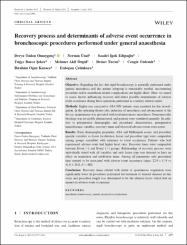| dc.contributor.author | Özden Omaygenç, Derya | |
| dc.contributor.author | Ünal, Nermin | |
| dc.contributor.author | Edipoğlu, Saadet İpek | |
| dc.contributor.author | Barça Şeker, Tuğçe | |
| dc.contributor.author | Özgül, Mehmet Akif | |
| dc.contributor.author | Turan, Demet | |
| dc.contributor.author | Özdemir, Cengiz | |
| dc.contributor.author | Karaca, İbrahim Oğuz | |
| dc.contributor.author | Çetinkaya, Erdoğan | |
| dc.date.accessioned | 10.07.201910:49:13 | |
| dc.date.accessioned | 2019-07-10T19:50:28Z | |
| dc.date.available | 10.07.201910:49:13 | |
| dc.date.available | 2019-07-10T19:50:28Z | |
| dc.date.issued | 2018 | en_US |
| dc.identifier.citation | Özden Omaygenç, D., Ünal, N., Edipoğlu, S., Barça Şeker, T., Özgül, M., Turan, D. ... Çetinkaya, E. (2018). Recovery process and determinants of adverse event occurrence in bronchoscopic procedures performed under general anaesthesia. Clinical Respiratory Journal, 12(7), 2277-2283. https://dx.doi.org/10.1111/crj.12904 | en_US |
| dc.identifier.issn | 1752-6981 | |
| dc.identifier.issn | 1752-699X | |
| dc.identifier.uri | https://dx.doi.org/10.1111/crj.12904 | |
| dc.identifier.uri | https://hdl.handle.net/20.500.12511/1991 | |
| dc.description | WOS: 000440416200016 | en_US |
| dc.description | PubMed ID: 29660267 | en_US |
| dc.description.abstract | ObjectiveRegarding the fact that rigid bronchoscopy is generally performed under general anaesthesia and this patient subgroup is remarkably morbid, encountering procedure and/or anaesthesia related complications are highly likely. Here, we aimed to assess factors influencing recovery and detect possible determinants of adverse event occurrence during these operations performed in a tertiary referral centre. MethodsEighty-one consecutive ASA I-IV patients were recruited for this investigation. In the operating theatre after induction of anaesthesia and advancement of the device, maintenance was provided with total intravenous anaesthesia. Neuromuscular blockage was invariably administered, and patients were ventilated manually. In addition to preoperative demographic and procedural characteristics, perioperative hemodynamic variables, recovery times and observed adverse events were noted. ResultsBasic demographic properties, ASA and Mallampati scores, and procedure specific variables as lesion localization, lesion and procedure type were comparable among groups assembled with reference to event occurrence. Patients who had experienced adverse event had higher heart rates. Recovery times were comparable between Event (-) and Event (+) groups. Relationship of recovery process were individually tested with all variables and only lesion type was detected to have an effect on respiration and extubation times. Among all parameters only procedural time seemed to be associated with adverse event occurrence (mins, 22.911.9 vs 41.6 +/- 28.8, P<.001). ConclusionRecovery times related with return of spontaneous respiration were significantly lower in procedures performed for treatment of tumoral diseases in this study and procedure length was determined to be the ultimate factor which had an impact on adverse event occurrence. | en_US |
| dc.language.iso | eng | en_US |
| dc.publisher | Wiley | en_US |
| dc.rights | info:eu-repo/semantics/embargoedAccess | en_US |
| dc.subject | Anaesthesia | en_US |
| dc.subject | Bronchoscopy | en_US |
| dc.subject | General | en_US |
| dc.subject | Peroperative Complications | en_US |
| dc.title | Recovery process and determinants of adverse event occurrence in bronchoscopic procedures performed under general anaesthesia | en_US |
| dc.type | article | en_US |
| dc.relation.ispartof | Clinical Respiratory Journal | en_US |
| dc.department | İstanbul Medipol Üniversitesi, Tıp Fakültesi, Dahili Tıp Bilimleri Bölümü, Kardiyoloji Ana Bilim Dalı | en_US |
| dc.authorid | 0000-0002-4281-0867 | en_US |
| dc.identifier.volume | 12 | en_US |
| dc.identifier.issue | 7 | en_US |
| dc.identifier.startpage | 2277 | en_US |
| dc.identifier.endpage | 2283 | en_US |
| dc.relation.publicationcategory | Makale - Uluslararası Hakemli Dergi - Kurum Öğretim Elemanı | en_US |
| dc.identifier.doi | 10.1111/crj.12904 | en_US |
| dc.identifier.wosquality | Q3 | en_US |
| dc.identifier.scopusquality | Q3 | en_US |


















